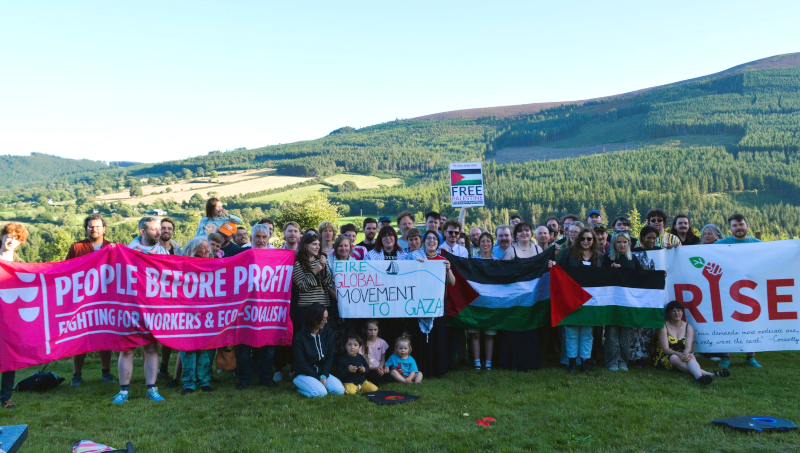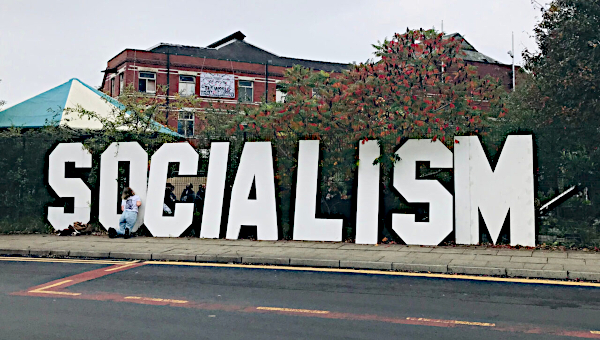There’s an apartment building in Dorchester that used to be a safe and affordable place to live for working-class families in Boston. But after a corporate landlord bought it in 2013, it has become a case study in how displacement happens. First, he allowed it to fall into extreme disrepair. As the building deteriorated, leaks developed, mold started growing, and people started moving out. After they left, the landlord cleaned up their units and rented them at significantly higher rates.

When City Life/Vida Urbana volunteers (of which I am one) started organizing in the building, people were scared and alienated from each other. As we started holding meetings, tenants began to connect with each other and learn their rights. After they pressured the landlord to make some minimal changes (which barely got the building up to code), the landlord raised their rent. For five months, the tenants have remained united in their refusal to pay the rent increase. They are paying the old rent and pressuring the landlord to meet with them as a tenants’ association and negotiate a fair rent increase.
The point of our organizing, however, is never solely to prevent displacement or improve conditions or negotiate fair rent increases. Although those wins are important and obviously do real good in real people’s lives, they are just one of the “legs” we should be walking on as we organize. What is the second “leg”? It is how all those involved in the organizing evolve and change over time through their engagement in the struggle.
“Walking On Two Legs”
This concept of “walking on two legs” was a key point made by Michael Lebowitz and Marta Harnecker, who traveled through several U.S. cities recently as part of a LeftRoots-organized tour, and spoke with organizers about the concept of not just fighting for change but also “producing ourselves differently” in the process of that fight. “In revolutionary practice,” according to Lebowitz, there is “simultaneous changing of circumstances and self-change. We change ourselves through our activity. We have to struggle not just to save the world but to save ourselves.”
Fighting to stop displacement, fighting to make housing a human right, fighting for an economic system that puts “people before profit” – that fight is one of the legs we walk on through the housing justice work we do at City Life. But how are we doing with the second leg – the fight to save ourselves, to be connected, to be fully human, to see ourselves as interdependent and capable of joining with others to creatively solve our problems?
At the building in Dorchester where long-time Boston residents are fighting for the right to remain in their communities, here are some of the ways we have strengthened the second leg:
1. We notice our importance.
The kind of systemic change that we are striving for will not be underwritten by funders and organized by paid staff working out of non-profits. Massive, grassroots-based organizing that drives the kind of change we want to see must ultimately involve thousands and thousands of volunteers touching the lives of millions of people and bringing them into the movement. At our building in Dorchester, we’ve gotten a glimpse of what this could look like. Our team – almost all of whom have been directly affected by displacement and have fought it – acts like a structural reminder that we are all needed for the struggle. L and R have formed tenant associations in their own buildings and can speak first-hand about the process, the intimidation tactics the landlord uses, and the benefits of sticking together. P and J fought home foreclosure and can share with others the power of solidarity in fighting the worst excesses of the for-profit housing system. C and J have the capacity to make phone calls, develop flyers, and do the clerical tasks that help keep the wheels turning. These collective offerings, with support from the paid staff, have kept the organizing going for almost a year. We have backed each other, role-played with each other, stepped in for each other, debated each other, gone to the funerals of each other’s loved ones, and celebrated successes together. Oppression isolates us. Working together as a team does the opposite.
2. We develop.
When we started organizing in this building as City Life volunteers, we came in with a perspective that the tenants should unite to fight the corporate landlord, and that indeed has happened. However, there were other struggles in the building, including tensions around drug-use and prostitution, and we didn’t have a ready response for these tensions. Inspectional Services suggested calling the police, but tenants rolled their eyes at this idea. They’ve had too much experience with police not coming, coming too late, or coming and being unhelpful (to put it mildly). What has happened organically is that residents have noticed the emerging leaders in the Tenants Association and have sought them out for advice and support in dealing with this community tension. What are they doing about it? For now, they are simply trying to get those affected by the situation together to talk it over – a modest but potentially effective way forward that sidesteps the criminalization of more people of color and that exercises that second leg! In the process of fighting displacement, these tenants have further developed and refined the capacity to look to each other to solve problems.
3. We experience solidarity.
Perhaps the key transformation that has happened over time in this organizing effort is the realization that we are not alone. The tenants in the building now have each other’s phone numbers, know each other’s names, and confide and build with each other. But more than that, they have had the experience of “complete strangers” (i.e., other City Life members) showing up at a Speak-Out in front of their building. And they, in turn, are joining with other grassroots organizations in the fight for a citywide ordinance for Just Cause Eviction, which provides important protections for renters throughout the city.
4. We build a political home.
With City Life, activists and tenants have an organizing home – a place where we can take lessons back to others doing similar work; where we can be held accountable for our work; where we can learn skills and contribute to strategic decisions about how to fight for housing justice in our city. In addition, through City Life, we have access to opportunities to study, to learn theories of change, to develop our worldview. But we need more than this. To further strengthen the second leg, we need a political home. We need to see ourselves as members of a larger movement, joining with others across various struggles to develop a strategy for how to be greater than the sum of our parts.
Much of our organizing in the U.S. is guilty of having an over-developed first leg, which we use to hop and lurch toward our goals. We are doing the work with more attention to immediate outcomes than to the way it is developing us in the process. “Walking on two legs,” we stride forward in a more balanced way – changing the world while we change ourselves so that we are better able to change the world. •
This article was first published by teleSUR English.





